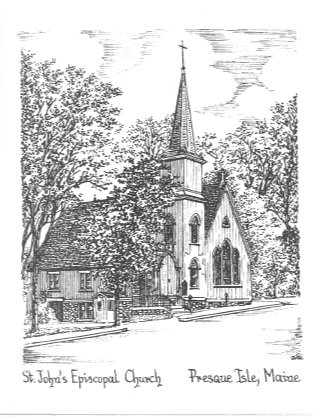Our story begins in 1869, when the Reverend William Washburn began holding monthly Episcopal services in space generously shared by the local Congregational church. In 1876, the fledgling congregation pooled their funds (with donations from others) and built their own meeting-house. At the time, the building was very barebones. Improvements would be made over the following decades.
In 1882, the trustees of the Presque Isle Academy, concerned about their institution’s decline, offered the academy’s property as a gift to any religious body willing to establish a first-class co-educational school. There were no takers. Luckily, the then-bishop of Maine had a special interest in the welfare of the County, owing to his time spent serving soldiers from the area as a Union Army chaplain. It is perhaps thanks to him that the Episcopal Diocese of Maine (the collective name for the federation of Episcopal churches across the state) decided to contribute funds to this worthy cause. Mr. Sawyer, our minister at the time, was able to secure a plot of land at a bargain price (thanks to the generosity of Cynthia and Charles Clark, the owners of the land) and use the funds provided by the diocese to erect a set of buildings upon it. St. John’s Classical School (today the University of Maine at Presque Isle) opened in 1884, educating the area’s students until the establishment of Presque Isle High School. Shortly after setting up the school, Mr. Sawyer left us, and for the next couple years - in the absence of an ordained minister - the principals of the school (all laypeople) would lead services at the church building here on 2nd Street.
Historically, the church followed the national trend of having the Lord’s Supper once a month (the last Sunday of the month at St. John’s) and Morning Prayer the other Sundays. This was the case even during the tenure of a particularly “high church” (preferring fancy ritual as opposed to austere Reformed services) rector named Mr. Pulsifer. However, as far as can be determined, the only thing about him we might recognize as “high church” was his preference for the use of incense. He also explicitly preferred to be called “Mr.” rather than “Reverend”.
In the 1980s, our rector at the time, the Rev. Richard Watson, passed away unexpectedly. The congregation named the parish hall (the undercroft of the building) “Watson Hall” in his memory, which is the name it bears to this day. The Sunday school also planted white birches in the nearby lot. In 1986 the congregation entered into an agreement with St. Luke’s Church in Caribou (today a Seventh-Day Adventist church) that we would pool our ministerial funds and split the cost of supporting a priest who would serve both churches. This arrangement set a precedent for things to come: Today we have a similar partnership with St. Paul’s in Fort Fairfield and the Church of the Good Shepherd down in Houlton.
The first such rector was the Rev. Thomas Knox, who began leading monthly services at the retirement community of Leisure Village - cozy, informal services where they all worshiped seated around a table. These services continued under successive priests, until we halted them at the beginning of the COVID-19 pandemic so as not to endanger the residents or our clergy. We remain hopeful they will one day return. During Fr. Knox’s tenure other smaller improvements were made to the church building as well.
For over two decades (1975-1997) we offered use of the parish hall to long-time parishioner Dory Smith for a nursery school, Paddington’s Corner. More than 600 pupils passed through this (literally) hallowed institution’s doors over the course of its existence!
There’s more to tell, of course - There always is. Together we’re writing a new chapter of St. John’s history, but we are who we are as a congregation because of all that came before. What does the future hold? Come and see!
